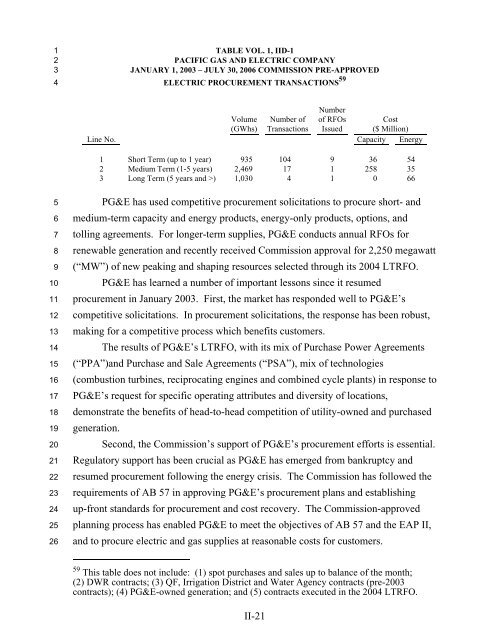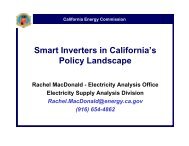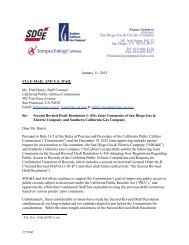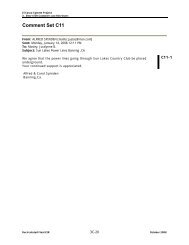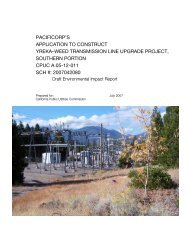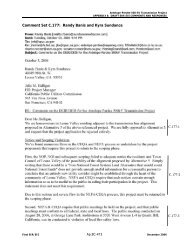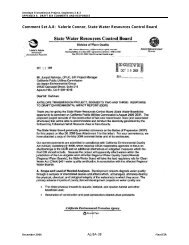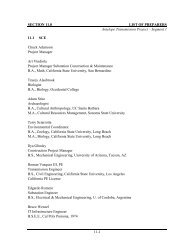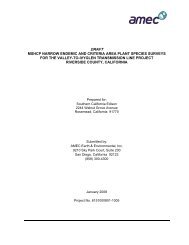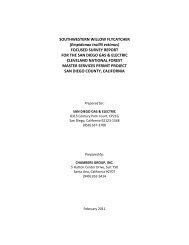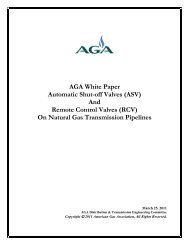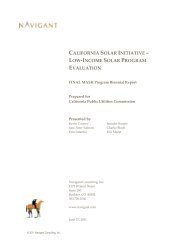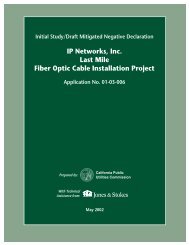Volume I. Part I - California Public Utilities Commission
Volume I. Part I - California Public Utilities Commission
Volume I. Part I - California Public Utilities Commission
Create successful ePaper yourself
Turn your PDF publications into a flip-book with our unique Google optimized e-Paper software.
1<br />
2<br />
3<br />
4<br />
5<br />
6<br />
7<br />
8<br />
9<br />
10<br />
11<br />
12<br />
13<br />
14<br />
15<br />
16<br />
17<br />
18<br />
19<br />
20<br />
21<br />
22<br />
23<br />
24<br />
25<br />
26<br />
TABLE VOL. 1, IID-1<br />
PACIFIC GAS AND ELECTRIC COMPANY<br />
JANUARY 1, 2003 – JULY 30, 2006 COMMISSION PRE-APPROVED<br />
ELECTRIC PROCUREMENT TRANSACTIONS 59<br />
<strong>Volume</strong> Number of<br />
Number<br />
of RFOs Cost<br />
(GWhs) Transactions Issued ($ Million)<br />
Line No. Capacity Energy<br />
1 Short Term (up to 1 year) 935 104 9 36 54<br />
2 Medium Term (1-5 years) 2,469 17 1 258 35<br />
3 Long Term (5 years and >) 1,030 4 1 0 66<br />
PG&E has used competitive procurement solicitations to procure short- and<br />
medium-term capacity and energy products, energy-only products, options, and<br />
tolling agreements. For longer-term supplies, PG&E conducts annual RFOs for<br />
renewable generation and recently received <strong>Commission</strong> approval for 2,250 megawatt<br />
(“MW”) of new peaking and shaping resources selected through its 2004 LTRFO.<br />
PG&E has learned a number of important lessons since it resumed<br />
procurement in January 2003. First, the market has responded well to PG&E’s<br />
competitive solicitations. In procurement solicitations, the response has been robust,<br />
making for a competitive process which benefits customers.<br />
The results of PG&E’s LTRFO, with its mix of Purchase Power Agreements<br />
(“PPA”)and Purchase and Sale Agreements (“PSA”), mix of technologies<br />
(combustion turbines, reciprocating engines and combined cycle plants) in response to<br />
PG&E’s request for specific operating attributes and diversity of locations,<br />
demonstrate the benefits of head-to-head competition of utility-owned and purchased<br />
generation.<br />
Second, the <strong>Commission</strong>’s support of PG&E’s procurement efforts is essential.<br />
Regulatory support has been crucial as PG&E has emerged from bankruptcy and<br />
resumed procurement following the energy crisis. The <strong>Commission</strong> has followed the<br />
requirements of AB 57 in approving PG&E’s procurement plans and establishing<br />
up-front standards for procurement and cost recovery. The <strong>Commission</strong>-approved<br />
planning process has enabled PG&E to meet the objectives of AB 57 and the EAP II,<br />
and to procure electric and gas supplies at reasonable costs for customers.<br />
59 This table does not include: (1) spot purchases and sales up to balance of the month;<br />
(2) DWR contracts; (3) QF, Irrigation District and Water Agency contracts (pre-2003<br />
contracts); (4) PG&E-owned generation; and (5) contracts executed in the 2004 LTRFO.<br />
II-21


